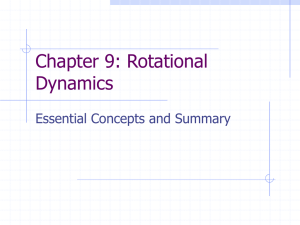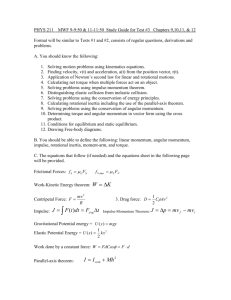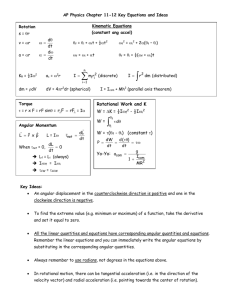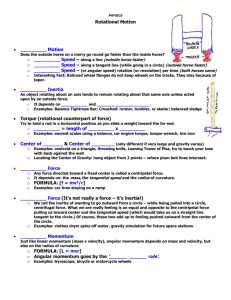Angular Momentum (of a particle)
advertisement
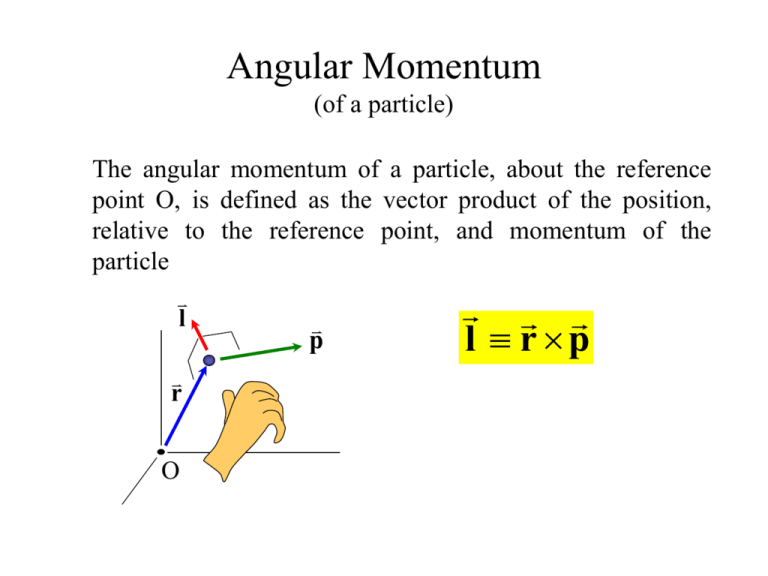
Angular Momentum (of a particle) The angular momentum of a particle, about the reference point O, is defined as the vector product of the position, relative to the reference point, and momentum of the particle l p l r p r O Torque Torque , about the reference point O, due to a force F exerted on a particle, is defined as the vector product of the position relative to the reference point and force F r O rF Newton's second law V (angular momentum of a particle) dr dp dp d dl p r r r Fnet net r p dt dt dt dt dt (In an inertial reference frame) the net torque, exerted on a particle, is equal to the rate of change of its angular momentum dl net dt Example. Kepler’s second law L dA r dr The gravitational torque (about the sun) exerted by the sun on the planets is a zero vector. dA 1 r dr 1 L r mv L const . dt 2 dt 2m 2m Newton's second law VI (angular momentum of a system) dL d dl li i net ,i int, i ext ,i ext ,i ext dt i dt i i i dt i i (In an inertial reference frame) the net external torque, exerted on a system of particles, is equal to the rate of change of its (total) angular momentum dL ext dt Example. What is the final angular velocity? initial i Initial total angular momentum (magnitude) L a 2 a mv a = 2a 2ma Final total angular momentum a final ? Lb 2 b mv b = 2b2 mb b From conservation of angular momentum (zero external torque): b a2 b 2 a Puzzle: Total kinetic energy K tot 2 mb 2b2 ma 22a a 2 2 2 ma 2 12a 0 2 2 b Who performed the work? Rigid Body A system in which the relative position of all particles is time independent is called a rigid body. vi The motion can be considered as a superposition of the translational motion of a point and the rotational motion around the point. rAi A i vi v A rAi Angular Momentum and Angular Velocity l L r’ In general, each component of the total angular momentum depends on all the components of the angular velocity. 2 r m r m r r i i L ri mi vi i i i i ri i i i L x mi zi x i ; i L y mi zi yi ; i Lz mi ri2 zi zi mi ri2 zi2 i i m r' i 2 i i effect of symmetry Only for object with appropriate symmetry the direction of angular momentum is consistent with the direction of angular velocity of the object L x m i z i x i 0 i L y m i z i y i 0 i 2 L z mi r 'i i I 2 mi r 'i i is called the moment of inertia (rotational inertia) of the body about the axis of rotation. Newton’s Law VII (for rotational motion of a rigid body) d dL ext I I dt dt For symmetrical rigid bodies, the angular acceleration is proportional to the net external torque. I ext Fixed and Instantaneous Axis of Rotation (Newton’s second law VIII) F F torque I d dL II ext , ext , dt dt The angular acceleration, of an object rotating about a fixed axis or instantaneous, is proportional to the component, along the axis of rotation, of the net external torque. Moment of Inertia (rotational inertia) A system of particles: IA 2 m r ' i i i r’ ri’ dm m i continuous body A I A r ' dm 2 body Example. Moment of inertia of a uniform thin rod about an end L Iy x2 y dx 0 3 L M M x dx L L 3 0 1 ML2 3 x L about the center L/2 Icm 3 L/2 M x M x dx L 3 L L / 2 2 L / 2 1 ML2 12 Example. Moment of inertia of a uniform circle r dr d R 2 M 2 2 r rddr I A r dm 2 R circle 0 0 M R 3 2 1 M R4 2 r d dr MR 2 2 R 2 0 0 R 2 4 Parallel - axis theorem C 2 I A r dm D r ' dm A 2 body body D r D dm r ' dm 2 D r ' dm 2 r' body dm 2 body MD IC 2D 0 body 2 If the moment of inertia of a rigid body about an axis through the center of mass is IC, then the moment of inertia, about a parallel axis separated by distance D from the axis that passes through the center of mass, is given by IA = MD2 + Ic Center of a force lift buoyancy lift weight If a certain body exerts a force on several particles of a given system, the center of the force is defined by position such that for any point of reference rcf f i ri f i i i Example. Center of gravity ri mi g miri g i i Mrcm g rcm Mg ri Wi The center of gravity in a uniform gravitational field is at the center of mass. Note: Not applicable to a nonuniform gravitational field Equilibrium of a rigid body F1 O A F3 F2 A rigid object is in equilibrium, if and only if the following conditions are satisfied: (a) the net external force is a zero vector, (b) the net external torque is a zero vector. Rotational kinetic energy The total kinetic energy of a system rotating about the point of reference is called the rotational (kinetic) energy K,o = Ki,o rotational energy and angular velocity The rotational kinetic energy is related to the magnitude of angular velocity and the moment of inertia of the body K , o K ,o K o,i i 1 I, o2 2 1 2 1 1 1 2 2 2 2 mi vi mi r 'i mi r 'i I 2 2 i i 2 i 2 Total Kinetic Energy of a Rigid Body K tot 1 2 1 2 mi vi mi v A ri i 2 i 2 1 1 1 2 2 mi vA mi ri mi 2 v A ri i 2 i 2 i 2 2 1 1 2 2 mi v A mi r 'i v A mi ri 2 i 2 i i If the center of mass is at point A K tot 1 21 2 KMv K I T cm , cm , cm 0 2 2 work and power in rotational motion dr F d d The differential work in a rotational motion depends on the torque about the point of rotation dW d dW F dr F d r d r F d The power delivered to a rigid body depends on the applied torque and the angular velocity of the body P Transformation of torque A , i A Fi rA B, i rB B A ,i rA ,i Fi AB rB,i Fi AB Fi rB,i Fi AB Fi B,i F conclusion (total force) A AB Ftot B If the total force applied to a body is zero, the torque of this force about any point has the same value. d -F torque transmission F

